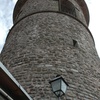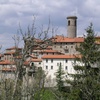Castle of Minucciano
The town of Minucciano is located on the border between the lands of the Garfagnana and Lunigiana, on a rocky outcrop from which you can enjoy a good view of the surrounding territory.
Little remains today of the ancient fortifications. The main evidence of the mediaeval era is the circular tower that stands at the centre of the small village; today its has clock but it was originally built to stand as an austere warning to those who approached. The village walls must have been made, for the most part, from the houses, according to the typical system of "wall-houses", but currently it is hard to identify the portions which have survived.
A few kilometres from the centre of Minucciano is the small town of Pieve San Lorenzo, which takes its name from the church, a masterpiece of Romanesque architecture of the area. Built with a structure of three naves marked by a double colonnade, it houses several paintings, including one representing the "Martyrdom of Santo Stefano".
Just outside the centre of Minucciano are the remains of Castle Bergiola, an extremely rich architectural complex, dating back to the thirteenth century and inhabited until 1920.
Historical notes
The existence of the village of Minucciano is reported for the first time in a document from 875, from which we learn that the village was under the Marchesi Malaspina, undisputed masters of the castle for centuries.
Towards the end of the thirteenth century, the government of Lucca managed to get its hands on the fortification for the first time. After a brief period of imperial rule – in 1313 the castle was given in fief from Arrigo VII to Spinetta Malaspina – Minucciano returned to gravitate in the Lucca orbit thanks to the military actions carried out by Castruccio Castracani.
With Castruccio dead, from 1328 Minucciano also experienced a period of political instability which Lucca and its county were subjected to until 8 April 1369, when Charles IV of Bohemia freed Lucca from the yoke of Pisa. At that time Minucciano had been occupied by Cecchinello of the coterie of the Nobles of Gragnano and with the military actions undertaken by the Elders of Lucca earning nothing, they finally resolved the issue by purchasing the fort for 100 gold florins.
The castle was always kept armed and was restored on many occasions, given its function of border control. In 1430, when Paolo Guinigi's government fell, the people of Minucciano decided to rely on the Florentine government. In 1449 the men of the castle Minucciano decided to return as part of the domain of Lucca, in spite of the ambassadors who came from Florence to try and dissuade the villagers, urging them instead to aggregate, if anything, with the Este who had once dominated much of the Garfagnana .
At this juncture, the governors of Lucca decided to reward loyalty and immediately promoted the municipality to the seat of the Podesta; later, in 1463, it was decided that Minucciano become home to a Vicariate for its key role as an outpost wedged inside the Este Vicariates. It was for this reason that in 1583 Minucciano was attacked by two hundred knights sent by the Duke Alfonso d'Este; between 1603 and 1618, in the war between Lucca and the Este, the castle of Minucciano was laid siege to on three occasions by the armies of the Duke, but the enemy never managed to cross its walls.










